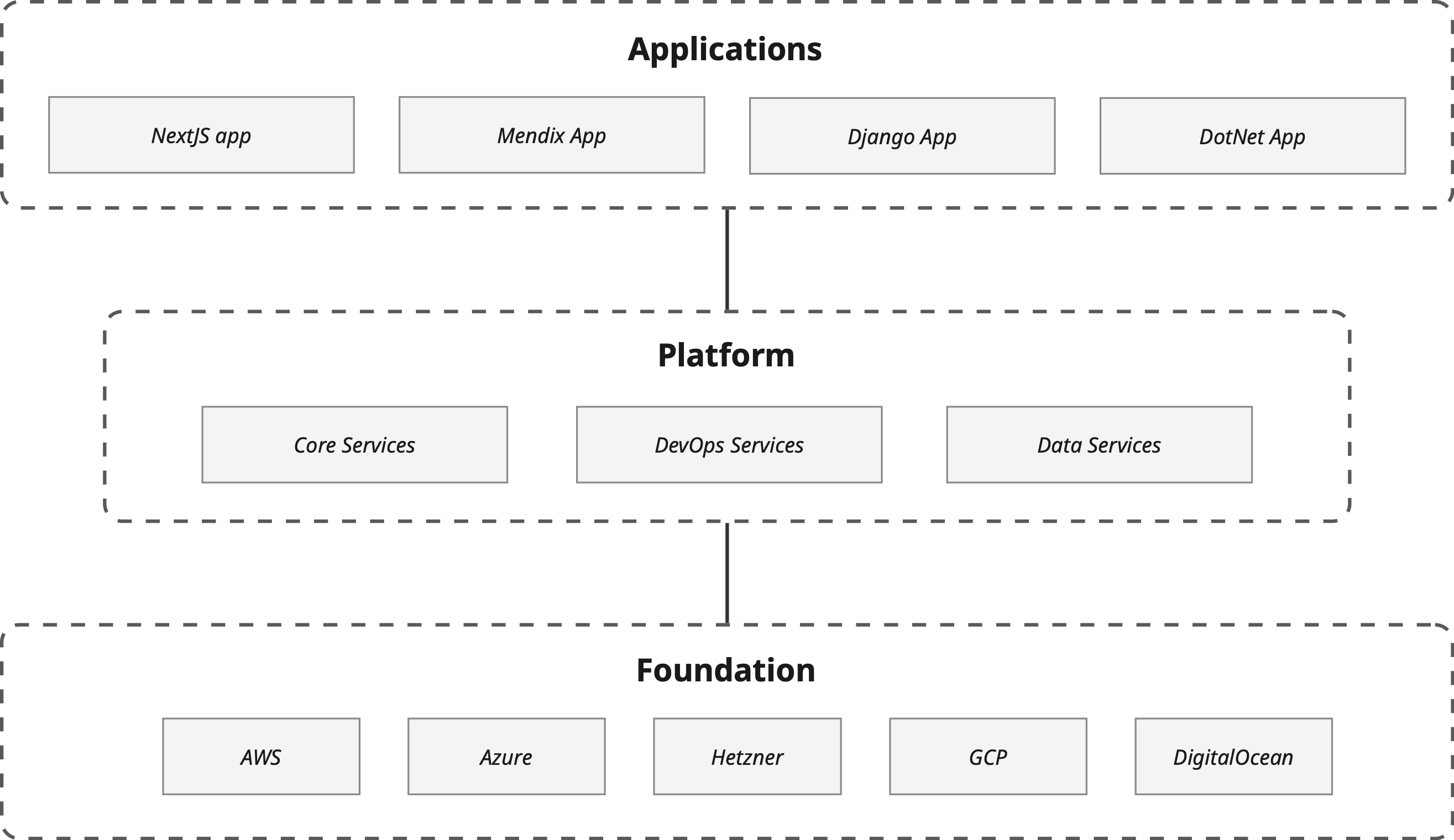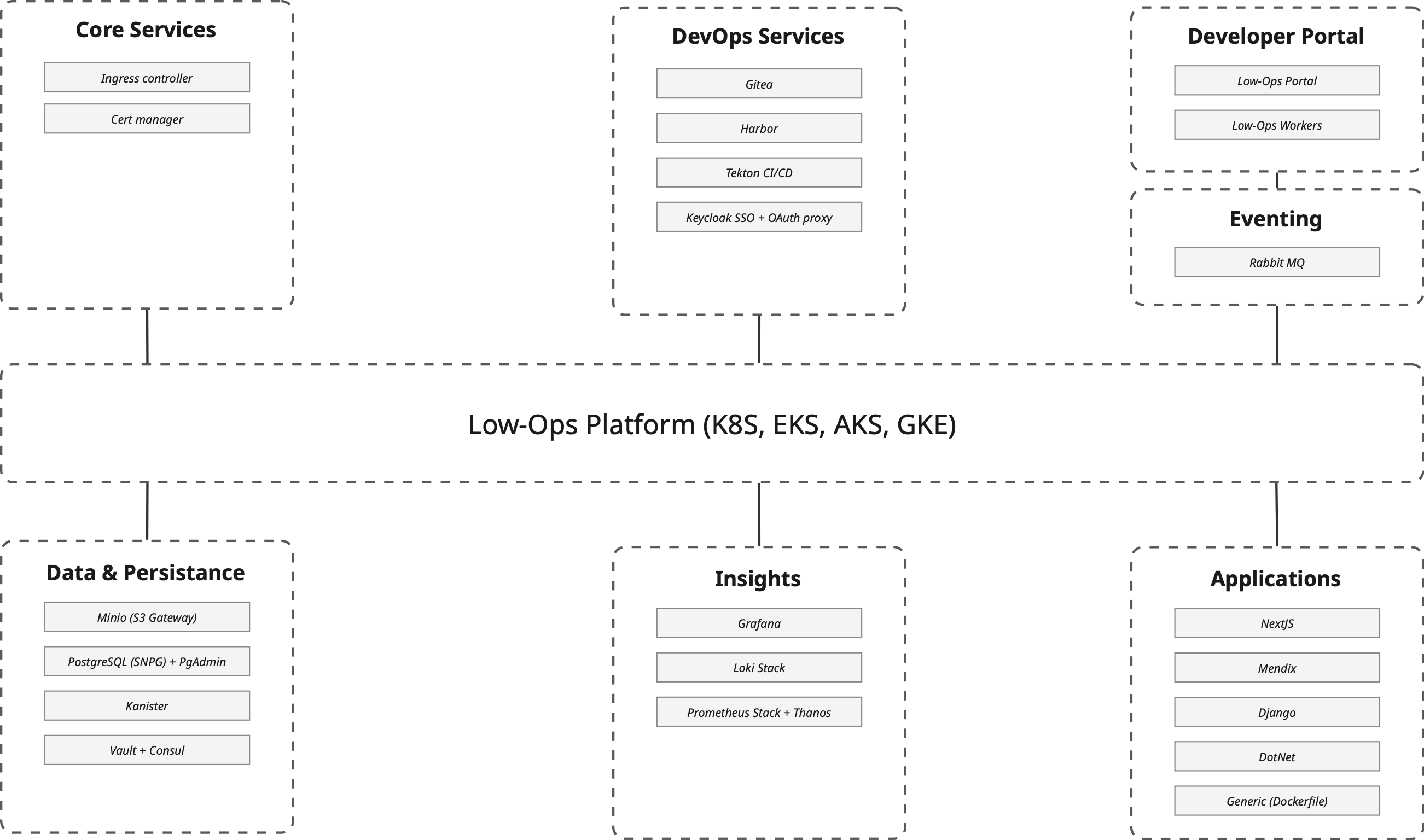High Level Architecture
Low-Ops is made up of a set of components that work together to provide a platform for running applications.
Low-Ops Layers
There are three main layers in Low-Ops architecture:
Applications- Custom-built applications that run on Low-Ops.Platform- The platform that runs the applications. It also provides a diverse set of services that are used by the applications or enables developers to build, deliver, and own their applications end-to-end.Foundation- The foundation that the platform runs on. This is the cloud provider or on-premise datacenter that provides a cloud-agnostic foundation which must be a Kubernetes cluster.

Philosophy
Deploying components onto Kubernetes is not rocket science. However, having the platform to be reproducible,
scalable, and maintainable is a challenge. Low-Ops is designed to be easy to use and requires minimal maintenance.
It is designed to be used by developers and operators with minimal knowledge of Kubernetes and cloud infrastructure. You
will be able to do all your tasks through the Low-Ops Portal supported with best practices of delivering applications
to your business and customers.
Because the whole platform is fully automated and runs on your infrastructure, you have 100% control over your data
and can be sure that it is secure. You can also easily integrate it with your existing systems and processes.
Don't want or need upgradability of Low-Ops? You can modify it to fit your needs. You can also use it as a starting point for your own platform.
LowOps is a modular, Kubernetes-based application platform that enables teams to deploy and manage a wide variety of
applications - including low-code Mendix apps and Generic Docker-based workloads - in a secure, observable, and
scalable way. It is designed to work across multiple environments: single VM, cloud (AWS, Azure), and
on-premises Kubernetes clusters.

Core Components
Core Layer
Ingress: nginx ingress controllerCertificates: cert-manager with Let's Encrypt for automatic TLS
DevOps Toolchain
Git: Gitea for Git-based source controlRegistry: Harbor with OCI scanning and MinIO backendCI/CD: Tekton pipelines for building, testing, deployingAuth: Keycloak as IdP + OAUTH-proxy for SSO-enabled services
Platform Portal
LowOps portal: Web UI for developers and operatorsLowOps workers: Background automation tasks triggered via UI or events
Event-Driven Core
RabbitMQ: Event transport for platform events, deployments, monitoring
Data Layer
S3 storage: MinIO in S3 Gateway mode (Azure Blob / AWS S3 backends)Databases: CNPG clusters (CloudNativePG) for apps and internal servicesBackups: Kanister for Kubernetes-native backupsSecrets & config: Vault for secret management, Consul for service discoverypgAdmin: DB UI for internal or debug usage
Monitoring & Observability
Metrics: Prometheus-stack + Thanos for HA + long-term metricsLogs: Loki-stack for log aggregationDashboards: Grafana with prebuilt and custom dashboards
Developer Experience
Interaction point: All developers use the LowOps portal (SSO protected) to:
- Create applications
- Monitor deployments
- Access logs, metrics, backups
- Trigger builds and promotions
Supported app types:
Generic: Any app using a Dockerfile (e.g., Django, Go, Node.js)Mendix: Fully supported, with deployment automation and CI/CD integrationNext.js: Treated as a dedicated framework due to frontend-specific workflows
Multi-Tenancy & Isolation
Namespace per app environment: Each application has isolated namespaces for each environmentAccess control: Managed via Keycloak SSO + Kubernetes RBACRegistry and S3 storage: Support project-based access segregation (Harbor projects, S3 buckets)